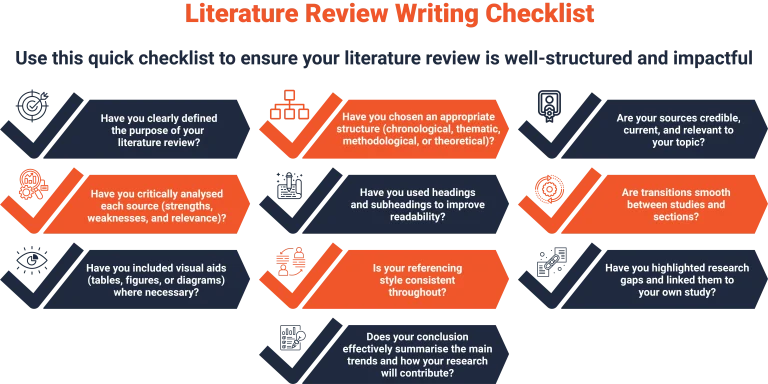Aliterature review is a structured discussion of the existing literature on a particular topic. The literature review shows where your study fit within the existing literature and identifies which questions remain unanswered. It also clarifies whether your research interest is already addressed and to what extent.
Key Takeaways:
- Selecting the proper structure for a literature review ensures that it remains clear, coherent, and engaging, making complex information easier to understand and follow.
- Using tools and management software makes the research process smoother, more accurate, and far less time-consuming.
- Strong literature reviews require a critical evaluation of sources, highlighting strengths, weaknesses, and connections, rather than simply summarising ideas.
A literature review is an important part of a dissertation, a polished research paper, or even a substantial assignment. The quality of your literature review ensures your research carries significant weight. A review that is methodically organised, supported by the appropriate tools, and formatted with precision demonstrates academic rigour, credibility and strengthens your overall argument.
In this blog, you will learn about the practical strategies to perfect your literature review.

How Do You Choose the Right Approach for Your Literature Review?
Choosing the right approach for your literature review depends on the type of research you are doing. Research type refers to the nature of your study, including the type of research question and the format, such as an essay, dissertation, or research paper. A topic with a limited studies can use a chronological outline, but for an extensive study, a thematic or theoretical approach is required.
Take your research skills to the next level
with our Level 7 Diploma in Education Management and Leadership today! Enrol Now
Common Structures for Organising a Literature Review
Organising a literature review needs a proper structure to make it more understandable. An adequate structure provides an appropriate framework for the review and creates a narrative that supports your argument. The following are the four typical structures used when organising the literature review.
Chronological Structure
This is the simplest method to organise your literature review chronologically. Structuring the review based on how the studies are published helps in tracking the evolution of theories, research approaches and gaps in the studies. The drawback of this method is that it prevents in-depth research. To make it relevant, you must connect each development stage with your own research problem, rather than stranding it.
Thematic Structure
A thematic structure groups studies under common themes, ideas, patterns, or debates. This is the most effective method for handling a wide range of subjects. This method simplifies the research process by identifying the areas of strength and research gaps. Thematic reviews tend to be more analytical, as they show relationships between different studies.
Methodological Structure
In this structure, a proper research method is applied, such as quantitative, qualitative or mixed methods. This enables you to critically examine the strengths and weaknesses of the existing studies. With this analysis, a research gap is identified and a suitable method is employed to address the research questions.
Theoretical Framework Structure
This framework is used to write a review based on the major theories related to your research interest. This structure addresses the contradiction in previous studies and discusses the results of different studies, providing an opportunity to demonstrate where your personal research aligns. This method is effective for writing dissertations, where the theoretical framework plays an important role in the argument.
Quick Comparison of Common Literature Review Structures
| Structure Type | Best For | Advantages | Limitations |
|---|---|---|---|
| Chronological | Topics with limited studies or historical progression | Shows evolution over time; easy to follow | Can become descriptive; lacks deep analysis |
| Thematic | Broad topics with multiple recurring themes | Highlights relationships and research gaps | Requires careful organisation to avoid overlap |
| Methodological | Studies with diverse research methods | Allows critical comparison of approaches | May focus too heavily on methods rather than findings |
| Theoretical Framework | Research grounded in key theories | Positions study within the existing theoretical context | Less useful if theories are limited or outdated |
What Tools and Resources That Can Help with a Literature Review?
Writing a literature review includes working with a number of resources. To look for the right resources and organise them, automated tools are required. There is a range of digital resources that can help you streamline the processes and make the organisation more efficient.
Reference Management Software
Reference management software helps you to store article links, PDFs and generate citations in various referencing styles with just a single command. The application of reference management includes EndNote, Zotero, and Mendeley. Using these tools saves time on managing each reference separately and manually.
Academic Search Engines
A search engine specifically designed for academic research is an essential component of writing a literature review. These search engines enhance the efficiency of finding research papers by utilising advanced techniques, including Boolean operators (AND, OR, NOT), filters for publication dates, and subject-specific keywords. Google Scholar, JSTOR, PubMed, and Scopus are among the most commonly used platforms for academic research.
Organisation Tools
It is a challenge to organise the selected resources according to the parts required in your research. There are many digital tools, like OneNote, Notion, Trello, or even Excel spreadsheets, that can serve as a system for categorising literature.
Visualisation Tools
Visualisation is important to add to your study to make the concept clear. Mind maps and concept maps can illustrate how theories are interconnected. Specialised software, such as VOSviewer, Canva, Google Drawing and Excel, can help you create diagrams to explain your review in a research study.
Want to develop advanced skills in academic writing and research?
Join Level 6 Diploma in Teaching and Learning and get started now!
How can You Format and Present Your Literature Review?
The formatting of a literature review has a direct impact on the readability and how your review communicates its argument.
Use of Headings and Subheadings: Use of a framework of headings and subheadings makes the literature easier to follow and read. Heading mirrors the structure and research method you are using in your research work.
Transitions: Transitions in a literature review are necessary to link one study to another. Phrases such as in contrast, similarly, or building on this help build relationships between studies, creating a cohesive discussion.
Critical vs. Descriptive Writing: A review that merely states what previous studies were about, without critically analysing them, lacks depth. Critical writing goes further by evaluating the significance of studies, questioning their strengths and weaknesses, and discussing their relevance to your research.
Tables and Figures: Visual elements simplify the complex information. This will help the writer stay organised and provide clarity to the readers.
Referencing and Citation Style: Institutions often suggest specific referencing and citation styles. The most common styles used are the Harvard, APA, and MLA styles. It is necessary to maintain a consistent style, preferably the Harvard Referencing Style; mixing formats can create confusion and undermine professionalism.

Conclusion
A literature review is the part that relates your work to existing studies. To write a good literature review, you need practical skills of properly structuring your review and utilising digital tools. This will present your discussion with clarity and cohesion. Writing a review in an organised way, with critical engagement and proper formatting, makes the review easier and more credible.





